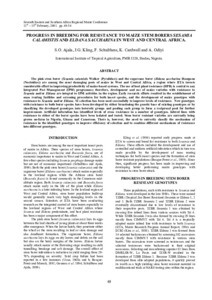| dc.contributor.author | Ajala, S. |
| dc.contributor.author | Kling, J. |
| dc.contributor.author | Cardwell, K. |
| dc.contributor.author | Schulthess, F. |
| dc.contributor.author | Odiyi, A. |
| dc.date.accessioned | 2019-12-04T11:21:06Z |
| dc.date.available | 2019-12-04T11:21:06Z |
| dc.date.issued | 2001 |
| dc.identifier.citation | Ajala, S., Kling, J., Schulthess, F., Cardwell, K. & Odiyi, A. (2001). Progress in breeding for resistance to maize stem borers sesamia calamistis and Eldana saccharina in West and Central Africa, 7th Eastern and Southern African Regional maize conference, 11-15 February, 2001, (p. 49-54) |
| dc.identifier.uri | https://hdl.handle.net/20.500.12478/3665 |
| dc.description.abstract | The pink stem borer (Sesamia calamistis Walker (Pyralidae)) and the sugarcane borer (Eldana saccharina Hampson (Noctuidae)) are among the most damaging pests of maize in West and Central Africa, a region where IITA invests considerable effort in improving productivity of maize-based systems. The use of host plant resistance (HPR) is central to any Integrated Pest Management (IPM) programme; therefore, development and use of maize varieties with resistance to Sesamia and/or Eldana are integral to IPM activities in the region. Early research efforts resulted in the establishment of mass rearing facilities and screening procedures for both insect species, and the development of maize genotypes with resistance to Sesamia and/or Eldana. S1 selection has been used successfully to improve levels of resistance. New genotypes with resistance to both borer species have been developed by either broadening the genetic base of existing genotypes or by classifying the developed genotypes into heterotic groups and pooling each group to form a reciprocal pool for further improvement. Artificial infestation has identified levels of cross resistance in a number of genotypes. Inbred lines with resistance to either of the borer species have been isolated and tested. Stem borer resistant varieties are currently being grown on-farm in Nigeria, Ghana and Cameroon. There is, however, the need to correctly classify the mechanism of resistance in the identified genotypes to improve efficiency of selection and to combine different mechanisms of resistance into different genotypes. |
| dc.language.iso | en |
| dc.subject | Genotypes |
| dc.subject | Sesamia Calamistis |
| dc.subject | Eldana Saccharina |
| dc.subject | Stem Borers |
| dc.subject | Maize |
| dc.title | Progress in breeding for resistance to maize stem borers sesamia calamistis and Eldana saccharina in West and Central Africa |
| dc.type | Conference Paper |
| dc.description.version | Peer Review |
| cg.contributor.affiliation | International Institute of Tropical Agriculture |
| cg.coverage.region | Africa |
| cg.coverage.region | West Africa |
| cg.coverage.country | Nigeria |
| cg.authorship.types | CGIAR single centre |
| cg.iitasubject | Maize |
| cg.iitasubject | Genetic Improvement |
| cg.iitasubject | Pests Of Plants |
| cg.iitasubject | Plant Breeding |
| cg.accessibilitystatus | Limited Access |
| local.dspaceid | 95820 |

